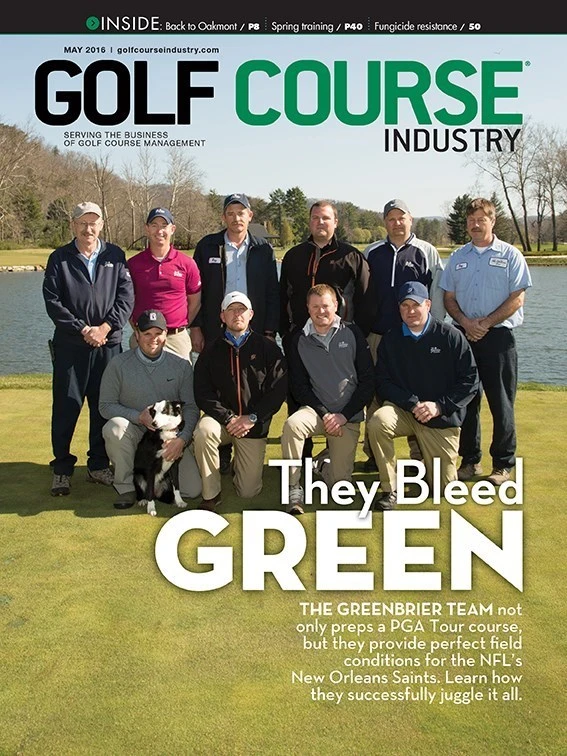The grainy black-and-white photo of 10 men standing behind the famed Pinehurst Putter Boy statue in 1947 is one of the most compelling images in the history of golf course architecture. It was the first meeting of the American Society of Golf Course Architects, hosted by Donald Ross, and attendees pictured included the likes of Stanley Thompson, W.B. Langford, William Bell, a young Trent Jones and, of course, Mr. Ross himself.
It was a very exclusive club in those days. Architects were more master craftsmen and artisans, and the group felt more like an old-school guild than a modern association. They were a band of competitors who came together because of a common interest … advancing the art, the science and, above all, the business of golf course design.
The society grew over the decades but the close-knit sense of guild remained. They even adopted the eye-popping red Ross clan tartan jackets that have become a familiar sight at GIS and other golf meetings. Golf went through big growth spurts along the way, notably the crazy go-go ‘80s and ‘90s when we built a zillion real estate anchor courses. Yet the membership of ASGCA remained elite and a growing number of designers, including many Tour pros who were lending their famous names to courses, were not part of the group.
The golf design business reached its apex in 2000 when 400 new courses opened in the U.S. Ironically, the last ASGCA annual meeting I had attended was in Columbus in 2001 ... the year that alarm bells were starting to sound about the market being overbuilt. Banks got nervous about funding construction in a crowded market and the design business slowed before coming to full stop in 2008. Since then we have closed five times more courses than we’ve opened.
But the past few years, things have been changing. We’re still only building a handful of new facilities (mostly spectacular destination courses) but clubs are getting smart and investing in renovation, remodeling and refreshing to be more competitive in the smaller golf market of the future. So, as I was honored to attend my first ASGCA meeting in 15 years last month in Washington, D.C., I found some startling and very promising changes in the organization:
The old guard was still well represented with Rees and Bob Jones, Roger Rulewich, John LaFoy, Bill Amick, Bill Coore and other legends attending, but young faces were everywhere. (Well, they looked young to me at least!) Many of the leadership positions are now held by energetic folks like Jason Straka, Mike Benkusky and even the newly installed president, Greg Martin. These people understand the modern golf business and are well-positioned to help the society grow and change. Not that old guys are bad (I’m proud to be one of them) but it’s always healthy to have new ideas and perspectives among your leadership.
There’s a sense of openness and optimism about the future. The pipeline for redesign work looks like it will be flowing for a decade. Yet every conversation I had confirmed ASGCA members work extremely hard to secure these projects and they take them very seriously. The quality of the work being done today and the demands from owners/clubs are both sky high. They treasure every project and take amazing pride in the outcomes.
The society is more integrated and connected to the golf community than ever before … a fact emphasized by both executive director Chad Ritterbusch and guest speaker Rand Jerris, the USGA exec who oversees facilities programs and the Green Section.
The program was inclusive of industry suppliers, including partners like Toro, Rain Bird, Troon, Landscapes Unlimited, Profile Products, Atlas Turf, Better Billy Bunker, Turf Drainage Co and Brookside Labs. There was a terrific panel discussion featuring Chris Hill of Course Crafters and supers Matt Shaffer (Merion), Scott Furlong (RTJ Club), Dave Swartzel (Bedford Springs) and Rocco Greco (Binghamton CC) where each talked about why they chose one of the newer bunker technologies.
Finally, there was remarkable camaraderie. Perhaps that’s one thing that’s changed the least over the years. It mirrored my thought about the modern-day Golf Course Builders Association of America and how the recession and the crisis in the construction market tended to weed out the part-timers and those who weren’t truly passionate about the business and left the true believers behind.
Nearly 70 years after that first small group of pioneers gathered at Pinehurst the ASGCA seems as dynamic and engaged in the market than ever before. I was grateful for the chance to see so many old friends again but, more importantly, I’m heartened about the future being shaped by many younger ones.
Get curated news on YOUR industry.
Enter your email to receive our newsletters.
Explore the May 2016 Issue
Check out more from this issue and find your next story to read.
Latest from Golf Course Industry
- GCSAA’s Health in Action 5K/2K reaches fundraising goal
- Landscapes Golf Management to participate in data analyzation initiative
- Reel Turf Techs: Carl Michael
- Atlanta Athletic Club approves funding for master plan
- Maximizing Cultural Practices and Agronomic Benefits with Minimal Surface Disruption
- Real Answers about Spray Nozzle Choices
- From the Course to the Factory: How Customer Insights Drive Innovation
- New & Proven Enzyme Strategies for Sprayable Thatch Management





